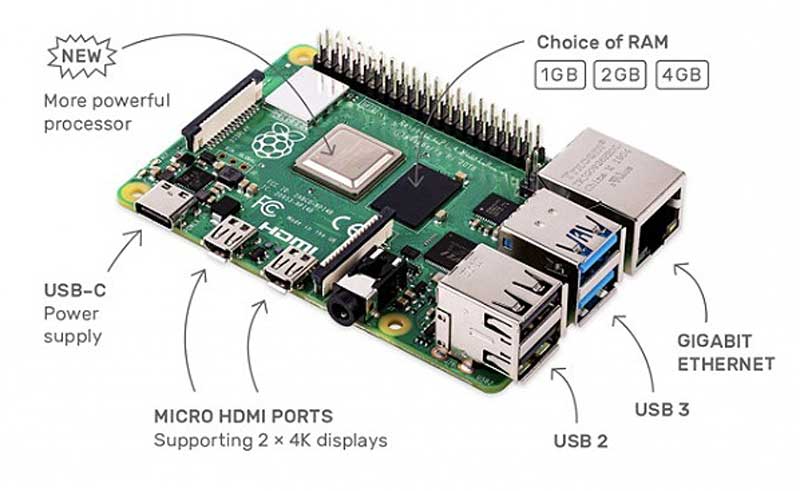The Raspberry Pi 4 has just released. This is the newest version of the Raspberry Pi and offers a better CPU and more memory than the Raspberry Pi 3, dual HDMI outputs, better USB and Ethernet performance, and will remain in production until January, 2026.
The Raspberry Pi Foundation announced the successor to its successful Raspberry Pi 3 line: the Raspberry Pi 4. This new model packs some big performance boosts and plenty of other new features onto a tiny motherboard.
Better Hardware
The Pi 4 boasts a Broadcom BC2711 SoC, which includes four ARM Cortex A72 cores running at a maximum speed of 1.5 GHz. Those Cortex A72 cores feature much-improved single-core performance over the A53 cores found in the previous-fastest Pi, Raspberry Pi 3 Model B+. The Pi 4 can come with one, two, or four gigabytes of LPDDR4 memory, where the previous models topped out at just one gig. The BC2711 also brings 802.11ac Wi-Fi and Bluetooth 5.0 wireless connectivity, as well as hardware decoding for 60 fps H.265 streams at 4K. The chipset isn’t the only thing that’s changing, however.
Specifications
- SoC: Broadcom BCM2711B0 quad-core A72 (ARMv8-A) 64-bit @ 1.5GHz
- GPU: Broadcom VideoCore VI @ 500MHz
- RAM: 1GB, 2GB, or 4GB LPDDR4–3200 SDRAM (4GB as reviewed)
- Networking: Gigabit Ethernet, 2.4GHz and 5GHz 802.11b/g/n/ac Wi-Fi, Bluetooth 5.0, Bluetooth Low Energy (BLE)
- Storage: MicroSD
- GPIO: 40-pin GPIO header, populated
- Ports: 2x micro-HDMI 2.0, 3.5mm analogue audio-video jack, 2x USB 2.0, 2x USB 3.0, Ethernet, Camera Serial Interface (CSI), Display Serial Interface (DSI)
- Dimensions: 88mm x 58mm x 19.5mm, 46g
More Power
The USB-C port should mean issues related to powering the board should mostly be a thing of the past. A USB Type-C connector accepts 5-volt, 2.5-amp AC adapters, and buyers who want to cut the AC cord entirely can use Power over Ethernet.
Extra Connectivity
The Raspberry Pi 4 now includes connections for a pair of 4K displays over HDMI 2.0 using dual Micro HDMI ports. Two of the four USB ports have been upgraded to the 3.0, while the other two maintain USB 2.0 connectivity. The Pi4 still includes the same 40-pin GPIO header, bootable Micro SD slot, and 3.5-mm analog audio connections, but its Ethernet jack has been bumped up to Gigabit speed.
The main downside I see from the announcement is that we’ll need to get micro HDMI cables or HDMI to micro HDMI adapters to connect Raspberry Pi 4 to HDMI TVs or monitors. Not a big issue.
Read More : Sweden’s Blood Bank Texts You Whenever Your Blood Saves A Life
Software Support
Much of what made the Pi series builders’ go-to choice for a single-board computer is its software support. Just like all Raspberry Pi models before it, the Pi 4 gets its software support from NOOBS, the Foundation’s OS management software. NOOBS supports Windows 10 IoT and many flavors of Linux, including Raspbian.
Great Price
$35 gets you the base model with 1GB of RAM memory, $45 bumps memory up to 2GB, and $55 gets you all the way to 4GB of RAM.
The addition of a second HDMI output is sublime, and turns the Raspberry Pi from a computer that would be a capable shop or workbench computer into something that could be considered a desktop replacement.
Do You Know Thing New to Add on Raspberry Pi 4? Share and Comment them on Aicrow.
